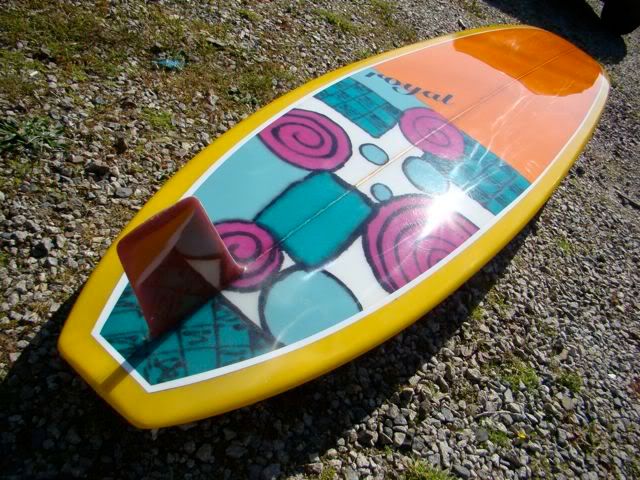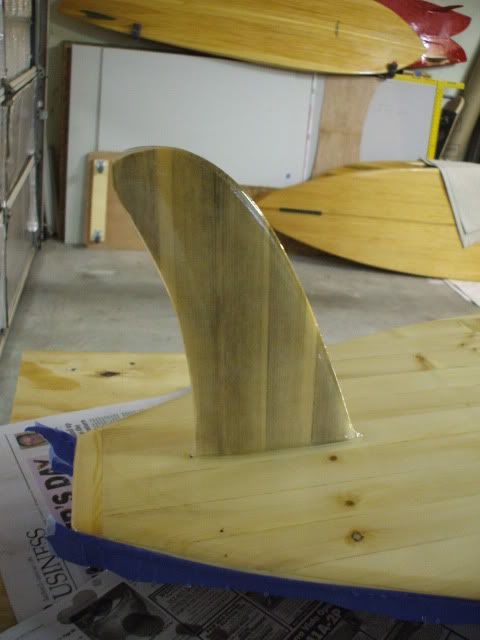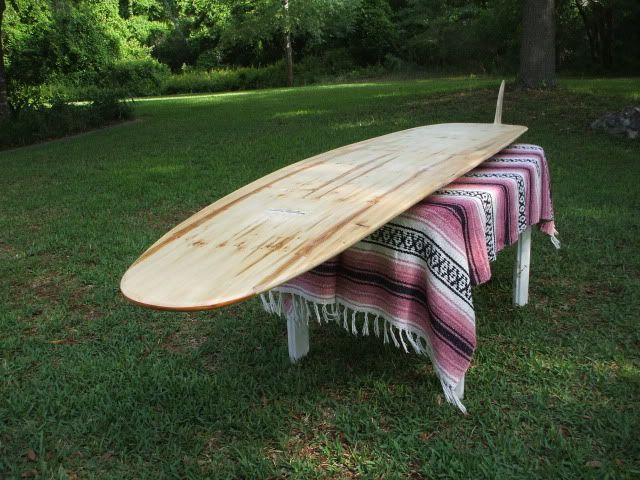Sorry
OK the next post is the one I wanted, don't know why it posted so many times since I didn't hit the post button but did hit the stop button one time to add to the post. Aloha,Kokua
Howzit Bill, I would have thought someone had tried it, like you said maybe someone will now. I would think more drive less pivot but that's just my 2 cents.Aloha,Kokua
The way the fin interacts with the board's bottom is a huge factor. Two fins with the exact same area, distributed differently as you point out will respond differently.
Cut-way bases affects fin flex characteristics fairly significantly unless the fin is stiff (or thick). I bought a cutaway bahne box that is super stiff. But taking a 'normal' fin and cutting the base will likely lose a lot of stiffness. Generally, glass fins do better in the cutaway dept.
More area towards the fin tip, as opposed to the base, slows a modern board's rail to rail response cuz there's more resistance. The impact of this is dependent on the surfer's style - guys with smoother styles wont mind much. Its not a coincidence that A.Merricks FCS shortboard fin design is wide base, small tips.
IMO, just about any board can be fine tuned with fin setup. This board was a dud at first, it got over a dozen changes and its truly magical.

pic of a recent experiment of a troublesome board. this board is fun as a twin. have custom quads for it that are not shown...made a whole bunch of fins for it...still experimenting. the board is super stiff and may not have much hope.
So as the fin is pressurised against the water during a turn and the water flows across the fin, the water turns the fins shape into performance......
[IMG]http://i153.photobucket.com/albums/s225/SURFFOILS/waterpassfin.jpg[/IMG]
So the longer the base length , the longer the effect of drive.
But where the base ends and the fin tapers,( if it does) the effect is one of a 'softening' of drive and the reduction of resistance or 'release', because the area of resistance is lessening and also moving further away from the junction of the board and fin.
The more upright the fin, the quicker the release. And the quicker the taper, the quicker the release. And the reverse holds true.
I know I can feel thru my feet how different fins aggressive or passively initiate a turn as well as the duration of hold and the speed of release.
Or is everyone already aware of this stuff ??

I used to really like the Greenough/hully fins on my longboards until I made this fin. I can’t be exact on the base at the moment, but can safely say it is 6" or maybe more, and 9" deep. Its a 747/757 style fin and all I can say is it is hands down the best fin I have ever made(easy for a board builder to make claims, but I really mean it!)

based in on something like this, but to be honest just took out the ruler to the fin panel, and drew some lines until it looked good…
It is super fast down the line, breaks trim with ease, pivots and does proper cutbacks, and comes flying out of bottom turns straight into the hook…It has a bit of twang to it since it is all cloth too, which I’m sure helps as well. Highly reccommend trying one if you can!
So, compared to the D fin I have on a similar board which has way more base, and probably more area, the 757 fin feels to have more drive by a longshot. Plus, you can actually feel it respond where some others I have don’t seem so active.
I also have this fin in another pig and find it might fit into what some are saying about bringing the width further up the fin:

it still isn’t as fun as the 757, but it is pretty close :)…loads of drive, yet still pivots/turns well. I’d like to scale this down to use on a keel fish as well and see how it goes, but seem to be lacking the time for all these experiments…lol
Lots of good comments. I just wanted to add my own recent experience. After many years of being a rake fin guy I switched to pivot fins. It’s made my longboards a lot more user friendly and controlable. I like the feel better and it just works better for me. Plenty of drive and not too much side slip.


There was a discussion a few years ago, I think started by Tom at Daum about a similar theory as it pertains to fin rake. The conclusion was that rake makes the fin or fin setup less "sensitive" (or softening as you put it) but it was related to foot positioning. I think your theory is good and relates to that discussion and I dont think its widely understood or known.
I think a convinient way to convey the idea is that of "smoothening" the response.
I also think fin rake does wonders on how fins flex and my personal preference is to have a fin that feels smooth (ie predictable) while enhancing the board's feel with good flex return. My best board is one with a really good design, combined with fins and board flex just the right way (feel), perhaps in synch or something (trippy feel).
Nice woodies!
[quote="$1"]
I also think fin rake does wonders on how fins flex and my personal preference is to have a fin that feels smooth (ie predictable) while enhancing the board's feel with good flex return. My best board is one with a really good design, combined with fins and board flex just the right way (feel), perhaps in synch or something (trippy feel).
[/quote]
Because with multi-fin systems, I can create pivot by simply adjusting the cluster spread, while keeping raked fins with smoothness and good flex.
Hey Rob, that board is looking sweet!
Hey guys, is there any possibility that we try to use a standardized nomenclature (when it exists) when discussing and/or describing characteristics of fins, foils, and various characteristics of planing, semi-planing, and displacement hulls, etc. It can be difficult enough for the reader when a single feature has lots of different names, but it becomes especially confusing when definitions are interchanged.
At a minimum, it would really help if the terminology used in aerodynamics and hydrodynamics, as well as by marine architects and plane designers were adopted by surfers whenever possible. For example, in the figure (below), the dimension labeled “height” is defined as the “span” of the foil within the fluid dynamics community, while the dimension indicated by “base” in the figure would be called the “root chord” (chord being the distance from the leading edge of the foil to the trailing edge as measured along a flow path (e.g. the blue lines parallel to the bottom of the board in another of Surffoil’s graphics), and “root” indicating the chord at the junction between the fin and the board.

That sounds good Terry,probably need the brains like Bill Thraillkill,Bill Barnfield,Bert, KCasey and Herb to work it out tho !
I'll stick with the simple stuff.
One question Ive always had is why does everyfin look the same ? well the leading edge does. They all have a swept back leading edge, but why ?
Sure some are really upright like The Spitfire Fin
[IMG]http://i153.photobucket.com/albums/s225/SURFFOILS/SF1-1.jpg[/IMG]
but why arent there any fins with cutaways in the leading edge..?
Howzit surffoils. Now you have opened ne thought an need to make one. Aloha,Kokua
I know there are a few odd ones already....
[IMG]http://i153.photobucket.com/albums/s225/SURFFOILS/boomerangfin.jpg[/IMG]
Fin on far left below.
[IMG]http://i153.photobucket.com/albums/s225/SURFFOILS/boomerfin.jpg[/IMG]
But not too many that are variations on the standard G3 or G5 classic shape.
Kokua, Ive already done a few....
Overlaying a G3 just to show the angle of the leading edge.
[IMG]http://i153.photobucket.com/albums/s225/SURFFOIL/SF2-1.jpg[/IMG]
Initially I tried it with the 'step' at the front...
[IMG]http://i153.photobucket.com/albums/s225/SURFFOIL/SURFFOILFINinitial.jpg[/IMG]
[quote="$1"]
One question Ive always had is why does everyfin look the same ? well the leading edge does. They all have a swept back leading edge, but why ?
[/quote]
1. Because nature and/or God designed that way (dorsal fins).
2. Because natural looking fins that work good sell. Goofy looking fins that dont work any better dont.
3. There is heaps of fin design variety available in the market. Some would say so much variety its confusing. Adding more goofy ones to the mix probably wont help unless there is a 'wow' factor.
4. Birds sweep back their wings when they want to go faster, as they do when they dive down from higher altitudes. Seabirds do this when they dive in the water for food.
Why swept back? In SoCal, kelp. In 1969 I made a fin type that are called Spitfire today. It was highly responsive, but would snag kelp and seaweed, sometimes stopping the board so abrubtly it would launch you off the front of the board. Crafty's four points, above, is a good summary.
Materials !!!
those plastic off-the-shelf pop out fins no matter what shape are useless for my fat a**
they always wash out on me.
carbonlites
foam core RDM
glass
or G10
makes a BIG difference in the amount of drive I get out of any fin design
Shape comes into play but I think its the core material and positioning that's more important.
Hell my wavegrinder periscope fin has more drive than my brothers greenough flex flin.
I always considered buying fins like buying suit ties until chandler set me straight.
But then deep down I kind already knew what he schooled me on,
cause we're always hoping you can buy some cheap fix to make things better than they should be
[quote="$1"]
[quote="$1"]
One question Ive always had is why does everyfin look the same ? well the leading edge does. They all have a swept back leading edge, but why ?
[/quote]
1. Because nature and/or God designed that way (dorsal fins).
2. Because natural looking fins that work good sell. Goofy looking fins that dont work any better dont.
3. There is heaps of fin design variety available in the market. Some would say so much variety its confusing. Adding more goofy ones to the mix probably wont help unless there is a 'wow' factor.
4. Birds sweep back their wings when they want to go faster, as they do when they dive down from higher altitudes. Seabirds do this when they dive in the water for food.
[/quote]
1. There are no naturally occurring surfboards because nature doesnt work with fibreglass,so dorsal fins work well on fish but highly tunes man-made surfcraft deserve the same in fins.
Following your theory all jet planes should have wings like pigeons.
2. What sells is whats advertised and has the QuikRipVanBong label on it. The H2's look goofy and theyve sold very well.
3. Back in the 70's,before FCS came and took over fins, a lot were hand made and there was some design progression, now theres so many other companies trying to replicate FCS's success,thats why theres so many similar fins out there.
4. Seabirds arent surfboards. And its not all about speed.
But there is a remarkable similarity amongst 99.9% of all surfboard fins, its like fin design has stood still for 30 years, a bit like surfboard design did.
